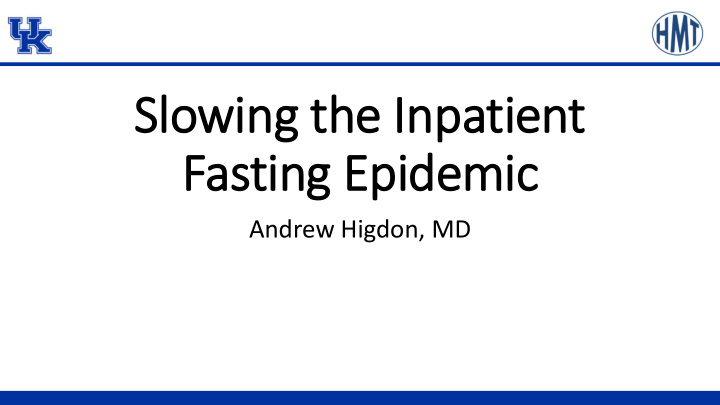



Slowing t g the I e Inpatien ent Fasting E g Epidem emic Andrew Higdon, MD
NPO now NPO at midnight
What t do o Guidelines Sa s Say? y? • 1999 – Anesthesia guidelines 1 • 2002 – Anesthesia guidelines 2 • 2017 – Anesthesia guidelines 3 1) Practice Guidelines for Preoperative Fasting and the Use of Pharmacologic Agents to Reduce the Risk of Pulmonary Aspiration. (1999). Anesthesiology , 90(3), pp.896-905. 2) Practice Guidelines for Sedation and Analgesia by Non-Anesthesiologists. (2002). Anesthesiology , 96(4), pp.1004-1017. 3) Practice Guidelines for Preoperative Fasting and the Use of Pharmacologic Agents to Reduce the Risk of Pulmonary Aspiration. (2017). Anesthesiology , 126(3), pp.376-393.
2 2 vs 4 4 hou ours of s of N NPO • Lower risk of aspiration (4) • Equivocal gastric volume (4) Cochrane Review • Equivocal gastric pH (4) • Less patient reported hunger (4) • Equivocal emesis, apnea, oxygen (5) Longer NPO ≠ Increased Safety 4) Brady, M., Kinn, S., Stuart, P. and Ness, V. (2003). Preoperative fasting for adults to prevent perioperative complications. Cochrane Database of Systematic Reviews . 5) Bell, A., Treston, G., McNabb, C., Monypenny, K. and Cardwell, R. (2007). Profiling adverse respiratory events and vomiting when using propofol for emergency department procedural sedation. Emergency Medicine Australasia , 19(5), pp.405-410.
What d t do o the p patients ts say? y? • BMJ Quality Improvement Reports, 2014 • Classic “at midnight” approach, patients reported • 70% subjective dehydration • 40% clinical evidence of dehydration • Clears until 2 hours before surgery • 25% subjective dehydration • 25% clinical evidence of dehydration 6) Hamid, S. (2014). Pre-operative fasting - a patient centered approach. BMJ Quality Improvement Reports , 2(2), pp.u605.w1252.
No Non-Anesthesi siol ologi gists? Assuming procedural sedation only (not general anesthesia) STILL clear liquids, then NPO 2 hours before procedure (7-8) Created in 2002, confirmed in March 2018 7) Practice Guidelines for Sedation and Analgesia by Non-Anesthesiologists. (2002). Anesthesiology , 96(4), pp.1004-1017. 8) Practice Guidelines for Moderate Procedural Sedation and Analgesia 2018. (2018). Anesthesiology , 128(3), pp.437-479.
Levels of s of Se Sedation Regular diet Clear liquids, then NPO for 2 hours
Ab About t ou our d data • 3 months: June - August 2017 totaling 441 patients • Used all 5 inpatient VA medicine wards teams only • Excluded neurology, surgical, and ICU services • Using coding data, analyzed patients with any NPO order placed: • Heart Catheterization • Bronchoscopy • Medical Management + No procedure performed • Other procedure
Potential Impact: 84% of patients NPO
Our V r Visio sion Implementation of a graduated diet and NPO in an inpatient population undergoing procedures with the goal of substantially decreasing the NPO duration in order to better adhere to contemporary evidence-based guidelines
Method ods • Multi-disciplinary coordination: • Dietary/Nutrition, Nurses, proceduralists, residents, hospitalists • Utilized design-based, rapid prototype development workshop with resident physician in UK Hospital Medicine Track for ideal menu design • New Clear Liquid Diet until 0800 hard-stop order • Order prompts door sign placement & appropriate dietary tray
Future Di Direct ction ons • Broaden implementation to other procedures and services • EGD • Colonoscopy • Stress Tests • IR Procedures – biopsies, tunneled lines, etc. • Surgeries • Transesophageal echocardiograms • Education efforts to reduce unnecessary NPO orders • NPO AM/PM • NPO menus progression
Cl Closi osing Th Thou oughts ts • Patients want a shorter NPO time • Guidelines say we should have a shorter NPO time • Studies show it’s safe to have a shorter NPO time
Recommend
More recommend